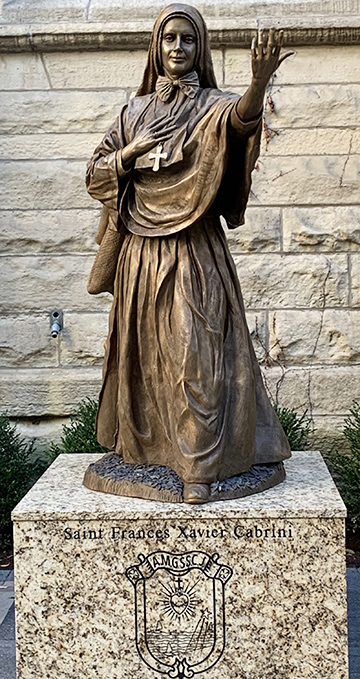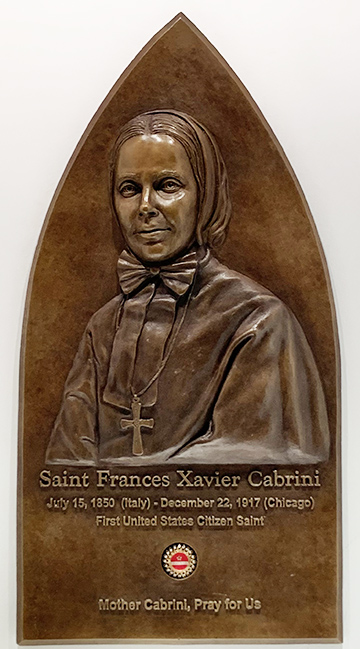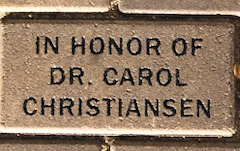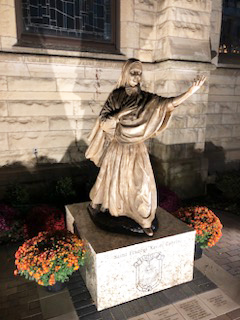By Ron Polaniecki, Chicago
(reprinted with permission of StreetWise Magazine, Chicago)



Recently a new sculpture of St. Frances Xavier (“Mother”) Cabrini (1850-1917) was unveiled in the courtyard of Holy Name Cathedral, located at State and Superior Streets.
“The occasion, in part, was the conclusion of a ‘jubilee year’ celebrating the 75th anniversary of Cabrini’s canonization (she is the first American citizen saint). And, in part, it is to recognize a Chicago-based woman who was indefatigable in her service to immigrants at the turn of the century,” says the Rev. Greg Sakowicz, rector of Holy Name Cathedral.
Her relevance is obvious in these times of immigration challenges. And her historic importance is confirmed by her inclusion in such works as Chicago and the American Century, The 100 Most Significant Chicagoans of the Twentieth Century by Richard F. Ciccone, and her listing in the National Women’s Hall of Fame, Seneca Falls, N.Y.
Francesca Cabrini was born prematurely in 1850, outside Milan, Italy, and was sickly throughout her life. Young Cabrini’s goal was to become a missionary to China. However, she was turned away from two religious orders because of her frail condition. Undaunted, Cabrini founded her own group, the Missionary Sisters of the Sacred Heart of Jesus (at a time when missionaries where almost exclusively male).
A path filled with twists and turns led her to Chicago where she founded, and then taught at, the Assumption School for Italian immigrant children, originally at 317 W. Erie St. It opened in 1899 with 500 children, and upon Cabrini’s insistence, it was free of charge.
The needs of her fellow Italians in Chicago grew rapidly as Chicago’s Italian born-population rose from 5,700 in 1890 to 16,000 in 1900 and to 45,000 in 1910. Like so many other immigrants, they lived in vastly overcrowded housing and worked for meager wages. One particular challenge faced by Italians was the lack of government or philanthropic agencies to advocate for them. Untypical of the times, Cabrini encouraged her sisters to teach young women industrial arts that would help them support themselves.
In addition to schools, hospitals were needed. Though lacking a healthcare background, her tireless zeal led to the founding of Columbus Hospital in Chicago, at first in Lakeview, and then Columbus Extension, located in a low-income neighborhood on Chicago’s West Side.
Even at a relatively young age, Cabrini was noted for organizational skills – and business instincts. For example, in purchasing the site for Columbus Hospital, she suspected the sellers were being dishonest. At 5 a.m., Cabrini and a fellow sister measured the land parcel themselves and discovered they were being cheated. Faced with the facts, the transaction was corrected.
Another example was her purchase in 1917 of a 102-acre farm in Park Ridge, near Northwest Highway and Dee Road. Her plan was to supply fresh milk, eggs, and chickens to the hospitals and orphanages she had established, according to Milton E. Nelson’s, Milestones of Park Ridge.
However, the other part of Cabrini’s legacy was walking the streets of the Italian district, consoling families, and delivering a message of faith in God to the needy residents. She never tired of asking for funds for the poor and advocating for the marginalized. Her simple motto was, “I can do all things in Jesus who strengthens me.”
Cabrini’s reputation grew. Over the years, she and her sisters founded 67 missions in many American cities, such as New Orleans, Seattle, Colorado mining towns; and in Argentina, Brazil, Nicaragua, and other nations.
As remarkable as Cabrini was, in her own realm, so, too, is co-sculptor, Lou Cella. Rotblatt Amrany Studio of Fine Art, Highwood, Ill., is his arena.
While Cella’s name is not well known, his works are. They include the sculptures of baseball legends Harry Caray, Ernie Banks, Billy Williams and Ron Santo outside of Wrigley Field. And Carlton Fisk, Frank Thomas and Paul Konerko at Guarantee Rate Field. And football hall-of-famer Bart Starr for the Green Bay Packers Heritage Trail, plus numerous other famous sports heroes.
While Cella acknowledges that he never sculpted a saint, he said he felt connections to Cabrini. He noted that he was raised Catholic, is a Chicagoan, and is part Italian. Further, he adds, his mother-in-law was an immigrant from Mexico.
Each subject is unique, Cella said. In this case, the goal was to depict Mother Cabrini reaching out from her heart (hence one hand is on her heart) with a deep concern for all people.
“The attention to details and personal touches, which is a hallmark of our studio work, is apparent in the fabric of the habit, her cross and ring,” Cella continues. “Also, she is stepping through delicate violets, which were her favorite flower.
“Cabrini did not check anyone’s credentials before she would help them,” Cella added. “And she had this special focus on immigrants as she was an immigrant herself.” She became a U.S. citizen in 1909.
Co-sculptor Jessica LoPresti, also an artist at the renowned Rotblatt Amrany studio, was, like Cella, new to saints. Like Cella, LoPresti is a Chicagoan, of Italian heritage on her father’s side and raised a Catholic.
A behind the scenes tidbit: LoPresti modeled a habit that was similar to what Cabrini wore. “This helped us capture the pose, the folds of the fabric, the delicate checkered pattern of the veil and other details.”
The statue was made possible by a donation from Dr. Carol Christianson, a former nurse for many years at Columbus Hospital as well as a missionary in service overseas.
LoPresti adds, “Cabrini’s message is relevant to our current society, which could benefit from having more compassion and care for others.”
Mother Cabrini passed away in Chicago in 1917 and her room is part of the National Shrine of St. Francis Xavier Cabrini in Lincoln Park.
11.30.2022
